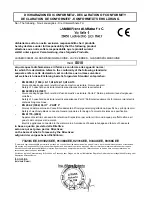
Any electrical work required to install this appliance
should be carried out by a qualified electrician or
competent person.
Any plumbing work required to install this appliance
should be carried out by a qualified plumber or competent
person.
Remove all packaging before positioning the machine.
If possible, position the machine next to a water tap and a
drain.
Water supply connections
This dishwasher may be fed with either hot (max. 60°) or cold
water.
Nevertheless we advise you a cold water supply.
A hot water supply is not always efficient with very soiled
crockery as it shortens the washing programmes a lot.
The water pressure must be within the limits given in the
technical specifications.
Your local Water Authority will advise you on the average
mains pressure in your area.
The dishwasher features fill and drain hoses which can be
turned either to the left or the right to suit the installation. The
locknut must be correctly fitted to avoid water leaks.
Do not use, for connection, old hoses which have been
used in another appliance.
Avoid bends or kinks in the hose which could prevent or slow
down the water supply.
If the machine is connected to new pipes or pipes which have
not been used for a long time, you should run the water for a
few minutes before connecting the inlet hose. This will prevent
deposits of sand or rust clogging the inlet hose filter.
For making the connection itself, the coupling nut fitted to the
machine’s supply hose is designed to screw onto either a 3/4
inch gas thread spout, or to a purpose made quick-coupling
tap such as the Press-block.
The
inlet hose is fitted with a safety device to
prevent inadvertent loosening.
To detach the hose, press the
lever (B) and turn the
retaining ring (A)
anticlockwise.
Water outlet hose connection
The end of the drain hose can be connected in the following
ways:
1. To the sink outlet spigot, securing it if necessary with a clip.
2. To a stand pipe provided with vent-hole, minimum internal
diameter 4 cm.
The waste connection must be at a height of between 30 cm
(minimum) and 100 cm (maximum) from the bottom of the
dishwasher.
The drain hose can face either to the right or left of the
dishwasher
Ensure the hose is not bent or squashed as this could prevent
or slow down the discharge of water.
If you use a drain hose extension it must be no longer than 2
metres and its internal diameter must be no smaller than the
diameter of the hose provided.
Likewise the internal diameter of the couplings used for
connections to the waste outlet must be no smaller than the
diameter of the hose provided.
The sink plug must not be in place when the machine is
draining as this could cause the water to siphon back into the
machine.
Attention!
Our appliances are supplied with a security device to
protect against the return of dirty water back into the
machine. If the spigot of your sink has a "no return valve"
incorporated this can prevent the correct draining of your
dishwasher.
We advise you therefore to remove it.
Electrical connection
Before plugging the appliance into the wall socket, make sure
that:
1. The mains voltage corresponds to the voltage given in the
"Technical specifications".
2. The meter, fuses, mains power supply and wall socket can
all take the maximum load required.
Make sure that the socket and plug are compatible without
having to use any type of adaptor. If necessary, have the
domestic wiring system socket replaced.
Safety standards require the appliance to be earthed.
The manufacture accepts no liability for failure to observe
the above safety precautions.
15
Installation instructions
A
CA14
B
min 30 cm
max 100 cm
max 100 cm
+ 2 m max
CS10
Ø 18
Ø 21
CS13
min 30 cm
max 100 cm
min 4 cm
Ø 21
Ø 18
1
2
Содержание ZDI 6744
Страница 1: ...DISHWASHER ZDI 6744 Instruction book KOR ...


































